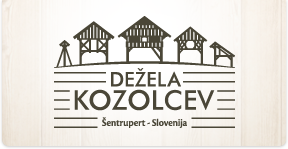
Zatler’s toplar from Rakovnik pri Šentrupertu
Zatler’s toplar (double hayrack), a bound kozolec with an extension, or “tail”, stood at the homestead of the Bizjak family, knows as the Zatlers locally, in the east side of the village Rakovnik, house number 4 in the Municipality of Šentrupert. The kozolec was placed among the apple trees in the fruit garden. The owner was a farmer and craftsman – “komatar”, from which the name Zatlers originates (from German “Sattler”: craftsman making and repairing large leather objects such as saddles, suitcases; saddler). The original owner was a saddler by trade, while the grandson of the first owner took it up as a hobby in the mid-20th century. The farm shrunk in size after the war due to nationalization, and encompassed arable land, meadows, forests, and a vineyard. The family lived of the land, growing grains: wheat, barley, oats, corn, buckwheat, rye, and millet, along with other produce – vegetables for feeding people and animals. The surplus was sold on the farm, while the potatoes were sold as far away as Trbovlje.
Zatler’s toplar is registered as immovable cultural heritage at the Ministry of Culture. The initials I.B. cut into the main façade of the kozolec indicate that it was probably commissioned by the first owner of the homestead, Ignac Bizjak, who moved into the area from the Gorenjska region in the second half of the 19th century. Beside the initials, the façade also bear the number of the year it was built – 1878, however, the master carpenter is not known.
The toplar boasts a “gank” (balcony) and a clay tiled gable roof. It has three pairs of windows and a “tail” shaped like a double parallel kozolec with a single window. The pillars stand on stone platforms and the cross-arms are decorated. The central ornament on the main façade is a ventilation embrasure in the shape of a monstrance.
Zatler’s toplar is made primarily of oak and partially of spruce wood. It measures 10 m in length, 6 m in width, and 8.10 m in height.
Hayracks
- Ostrvi from Bela Krajina
- Roofless kozolec from the Ribnica valley
- Lah’s kozolec from Migolica
- Pluskar’s kozolec from Brezovica pri Mirni
- Šraj’s kozolec from Velike Pece
- Rantah’s kozolec from Vrh
- Šepec–Lash’s kozolec from Dolenja Nemška vas
- Lap’s toplar from Bistrica near Šentrupert
- The hill toplar from Prelesje
- Kamnar’s toplar from Ravnik
- Blašč’s kozolec from Praprotnica
- Zatler’s toplar from Rakovnik pri Šentrupertu
- Luka’s toplar from Trstenik
- Grčarjev toplar
- Franckov kozolec from Draga pri Šentrupertu
- Žmavčev kozolec from Straža
- Ziherle’s toplar from Slepšek
- Gabrijel’s kozolec from Rodine pri Trebnjem
- Jurglič’s toplar from Prelesje
Additional info
Location
Opening hours
-
monday
9.00 - 12.00
13.00 - 16.00 -
tuesday
9.00 - 12.00
13.00 - 16.00 -
wednesday
9.00 - 12.00
13.00 - 16.00 -
thursday
9.00 - 12.00
13.00 - 16.00 -
friday
9.00 - 12.00
13.00 - 16.00 -
saturday, sunday and hollydays
By agreement
